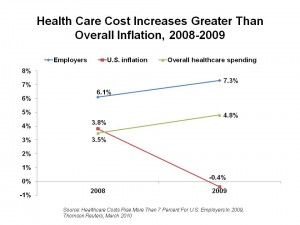 Inflation in the U.S. fell by 0.4% in 2009, the first such annual decline in the Consumer Price Index since 1955.
Inflation in the U.S. fell by 0.4% in 2009, the first such annual decline in the Consumer Price Index since 1955.
At the same time, health care costs for American employers grew 7.3% per capita in 2009.
As the chart health spending increased nearly 5%, with employers’ costs increasing even more quickly over the year. This was especially twice-as-onerous for small and mid-sized companies whose costs grew much faster than for larger companies, whose rate of increase actually fell in the year. These sobering statistics were calculated by Thomson Reuters and published in Helathcare Costs Rise More Than 7 Percent For U.S. Employers in 2009.
The largest percentage increases were in outpatient services (utilization and price increases growing relatively equally) and emergency room costs.
![]()
A Milliman Healthcare Reform Briefing Paper, Healthcare Cost: Manage the causes, not the effect, the actuaries argue not to look at the insurance premium, but at the underlying costs driving medical inflation. Milliman calculates that it’s these costs that make up 85% of most premiums. The firm argues for a mandate for all Americans to purchase health insurance to effectively spread risk.
Second, Milliman simplifies the cost equation as “Unit price x Utilization = Cost.” As Uwe Reinhardt has pointed out in a landmark Health Affairs article, “It’s the Prices, Stupid.” Of course, utilization is also driven up by a reimbursement system based in fee-for-services delivered. It’s not only the prices, but it’s the incentives.
These actuaries have it right: while getting to cost reductions while enhancing quality is no easy task, it is do-able with information, tools and technology. These are, interestingly, the learnings and understandings of Donald Berwick, President Obama’s designee to lead the Centers for Medicare and Medicaid Services.




 Thank you, Trey Rawles of @Optum, for including me on
Thank you, Trey Rawles of @Optum, for including me on  I was invited to be a Judge for the upcoming
I was invited to be a Judge for the upcoming  For the past 15 years,
For the past 15 years,